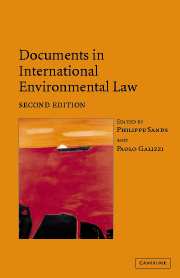Book contents
- Frontmatter
- Contents
- Preface
- PART I General instruments
- PART II Atmosphere
- PART III Oceans: global
- PART IIIB Oceans: regional
- PART IV Freshwater resources
- PART V Biodiversity
- PART VIA Hazardous substances and activities: nuclear
- PART VIB Hazardous substances and activities: pesticides
- 26 Convention on the Prior Informed Consent Procedure for Certain Hazardous Chemicals and Pesticides in International Trade, 10 September 1998
- 27 Convention on Persistent Organic Pollutants, 22 May 2001
- PART VIC Hazardous substances and activities: waste
- PART VII Human rights and the environment
- PART VIII War and the environment
- PART IX Trade and the environment
- PART X Environmental impact assessment and access to information
- PART XI Liability for environmental damage and breaches of environmental obligations
- PART XII The Antarctic
26 - Convention on the Prior Informed Consent Procedure for Certain Hazardous Chemicals and Pesticides in International Trade, 10 September 1998
Published online by Cambridge University Press: 05 June 2012
- Frontmatter
- Contents
- Preface
- PART I General instruments
- PART II Atmosphere
- PART III Oceans: global
- PART IIIB Oceans: regional
- PART IV Freshwater resources
- PART V Biodiversity
- PART VIA Hazardous substances and activities: nuclear
- PART VIB Hazardous substances and activities: pesticides
- 26 Convention on the Prior Informed Consent Procedure for Certain Hazardous Chemicals and Pesticides in International Trade, 10 September 1998
- 27 Convention on Persistent Organic Pollutants, 22 May 2001
- PART VIC Hazardous substances and activities: waste
- PART VII Human rights and the environment
- PART VIII War and the environment
- PART IX Trade and the environment
- PART X Environmental impact assessment and access to information
- PART XI Liability for environmental damage and breaches of environmental obligations
- PART XII The Antarctic
Summary
Editorial note
The objective of the 1998 Rotterdam Convention on the Prior Informed Consent Procedure for Certain Hazardous Chemicals and Pesticides in International Trade (1998 Chemicals Convention) is ‘to promote shared responsibility and cooperative efforts among Parties in the international trade of certain hazardous chemicals in order to protect human health and the environment from potential harm and to contribute to their environmentally sound use, by facilitating information exchange about their characteristics, by providing for a national decision-making process on their import and export and by disseminating these decisions to Parties’ (Article 1).
The Convention draws upon the FAO and UNEP voluntary schemes in applying a prior informed consent (PIC) procedure for chemicals listed in Annex III of the Convention, and is applicable to banned or severely restricted chemicals and severely hazardous pesticide formulations (Article 3(1)), subject to certain exceptions (Article 3(2)). Each party is to designate a national authority that shall be authorized to act on its behalf in the performance of the administrative functions required by the Convention (Article 4).With regards to chemicals, a party which has banned or severely restricted a chemical (taken a ‘final regulatory action’) is to notify the secretariat, which will then forward the information to all parties (Article 5(1) and (2)).With regard to pesticides, any party that is a developing country or a country with an economy in transition and that is experiencing problems caused by a severely hazardous pesticide formulation under conditions of use in its territory may propose to the secretariat the listing in Annex III of the severely hazardous pesticide formulation (Article 6(1)).
- Type
- Chapter
- Information
- Documents in International Environmental Law , pp. 813 - 837Publisher: Cambridge University PressPrint publication year: 2004



